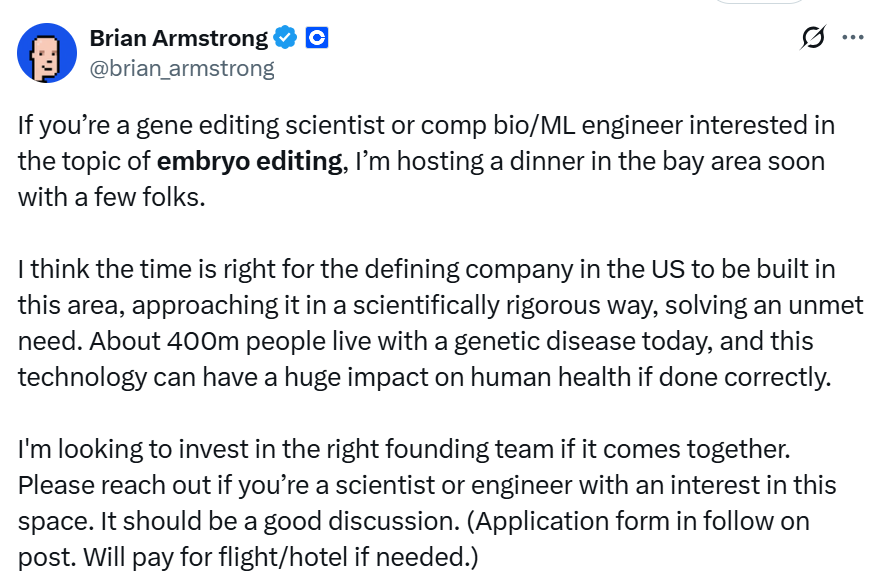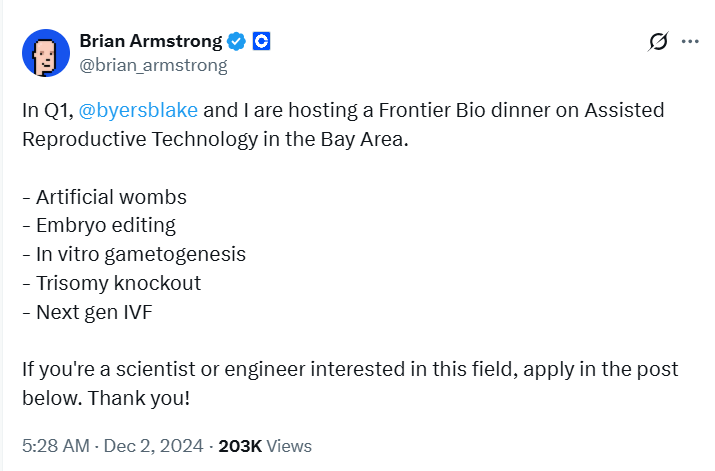Genomic editing not only has limited practical medical applications but also poses long-term risks with unknown consequences.
Author: Luo Hua, Antonio
Recently, billionaire and CEO of cryptocurrency exchange Coinbase, Brian Armstrong, announced that he is prepared to invest in a U.S. startup focused on human embryo gene editing.
He publicly recruited gene editing scientists or computational biology/machine learning engineers on social media platform X, intending to form a founding team to conduct "embryo editing" research targeting unmet medical needs, such as genetic diseases. He invited them to apply for a private dinner, where applicants needed to fill out a form answering several questions, including "What amazing thing have you created?"

He attached a picture of a Pew Research Center poll from seven years ago in his post. The poll showed that Americans strongly support changing the genes of babies if it could cure diseases, although the same poll also found that most people oppose experimenting on embryos.
Just a few weeks ago, several biotechnology industry organizations and academic groups jointly called for a 10-year moratorium on heritable human genome editing, pointing out that the technology not only has limited practical medical applications but also poses long-term risks with unknown consequences.
These organizations warned that the ability to "program" ideal traits or eliminate undesirable genes could lead to the emergence of a new form of "eugenics," fundamentally altering the trajectory of human evolution.

So far, no U.S. company has publicly conducted embryo editing research, and the federal government does not fund embryo research at all. In the U.S., embryo gene editing research is only conducted by two academic centers: one at Columbia University led by gene editing scientist Dieter Egli and another at Oregon Health & Science University.
Funding for such research is relatively limited, primarily relying on private grants and university funds. Many researchers at these centers have expressed their support for well-funded companies to advance this technology. "We sincerely welcome this kind of collaboration," said Paula Amato, a fertility doctor at Oregon Health & Science University and former president of the American Society for Reproductive Medicine.
They believe that if a billionaire lobbies for this, the ban on gene-edited babies could change.
In December 2024, Armstrong announced on X that he and investor Blake Byers were prepared to meet with entrepreneurs dedicated to "artificial wombs," "embryo editing," and "next-generation in vitro fertilization." The two co-founded NewLimit, a company that extends human health span through epigenetic reprogramming, which has raised nearly $300 million in funding. Byers has stated that a significant portion of global GDP should be allocated to "immortality" research, including biotechnological methods and ways to upload human consciousness to computers.

Now, a meeting for "embryo editing" entrepreneurs is on the agenda, scheduled to take place in the San Francisco Bay Area in the third quarter of 2025. Among the guests at the dinner will be postdoctoral researcher Stepan Jerabek from the Egli lab, who has been testing base editing technology in embryos; another guest, Lucas Harrington, is a gene editing scientist who studied under Nobel Prize winner Jennifer Doudna.
Harrington stated that a venture capital group he is involved with, called SciFounders, is also considering starting an embryo editing company. In an email, he said, "We hope to have a company that can assess the safety of embryo editing through empirical research and are actively exploring incubating a company to take on this work. We believe that professional scientists and clinicians are needed to safely evaluate this technology."
Additionally, he criticized the bans and moratoriums on the technology. He stated that these bans and pauses do not prevent the application of gene editing technology but may push it into the shadows, reducing its safety for use. He revealed that some biohacker organizations have quietly raised small amounts of funding to advance this technology.
In contrast, Armstrong's public statements on the X platform reflect a more transparent attitude. "This time it seems serious; they really want to push the project forward," Egli said. The scholar hopes that the Coinbase CEO can fund some of his lab's research, "I think his public statement is very valuable—it can gauge public opinion, observe reactions from all sides, and promote public discussion."
In 2015, news broke that researchers in China had conducted CRISPR gene editing on human embryos in the lab, causing a global stir—people realized how theoretically simple it was to alter human genetic traits. In 2017, a research report from Oregon claimed that they successfully corrected pathogenic DNA mutations in lab embryos cultivated from patient eggs and sperm cells.
However, this breakthrough harbored hidden dangers. Scholars like Egli found through more rigorous testing that CRISPR technology could actually cause severe damage to cells, often leading to large segments of chromosome loss. Besides the phenomenon of chimerism (where different cells exhibit differentiated editing), this seemingly precise DNA editing technology can result in imperceptible destructive consequences.

While the public engaged in heated debates over the ethical issues surrounding "CRISPR babies," the scientific community focused on fundamental scientific problems and their solutions. Subsequently, the industry shifted to base editing technology, which changes individual DNA bases. This method has fewer unintended effects and theoretically allows for multiple beneficial gene variations in embryos rather than a single modification. The earlier methods actually involved cutting the double helix structure, causing damage and leading to the loss of entire genes.
Currently, gene editing technology is only approved for treating adult diseases, with gene therapy for sickle cell anemia costing over $2 million. In contrast, the cost of embryo editing could be very low: if editing is done early in embryo formation, all somatic cells will carry the modified gene.
However, gene editing technology has not yet reached a mature stage for creating "designer babies." Achieving this goal still requires overcoming many technical challenges, including precisely designing editing systems and establishing systematic methods for detecting abnormal DNA changes in embryos. This is precisely the direction that the company Armstrong intends to invest in needs to tackle.
As of the time of publication, Armstrong had not responded to an email from the MIT Technology Review seeking comment on his plans, and his company Coinbase also did not respond.
免责声明:本文章仅代表作者个人观点,不代表本平台的立场和观点。本文章仅供信息分享,不构成对任何人的任何投资建议。用户与作者之间的任何争议,与本平台无关。如网页中刊载的文章或图片涉及侵权,请提供相关的权利证明和身份证明发送邮件到support@aicoin.com,本平台相关工作人员将会进行核查。



